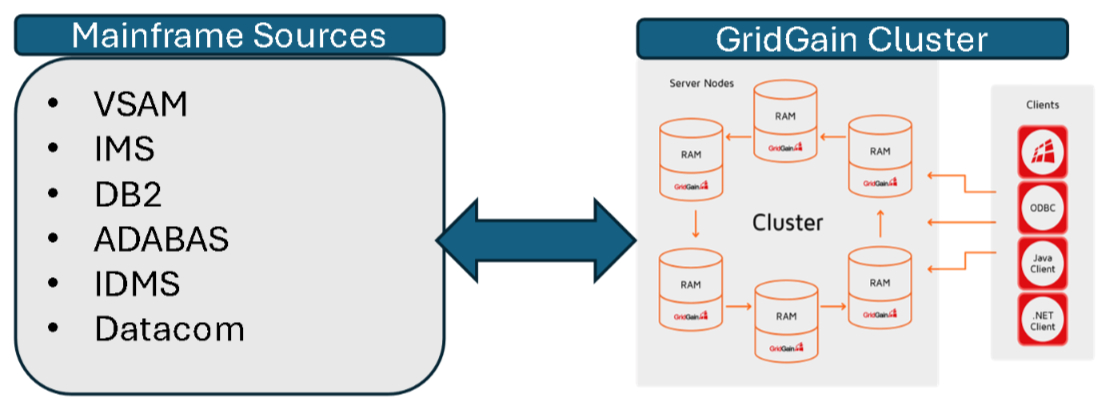Enterprises are under tremendous pressure to get the high return-on-investment often seen from fast, smart analytics. But these powerful modern analytical projects require access to all data across the enterprise, and even from partners, third parties, and clouds or cloud-analytic applications. While robust and reliable, legacy mainframe systems run up against limitations around data access and availability. Mainframes are proprietary, closed systems. Enterprises looking to process all the data they own or can procure for reliable intelligence have to make access to data from legacy systems easier.
One obvious solution is integration of these older systems with the new, modern applications. But mainframe integration isn’t as simple as it sounds. It needs to be done using a measured, risk-averse strategy.
One promising solution to get the highest value from a mainframe integration project is to use a real-time digital integration hub with a platform like GridGain at its heart. This allows you to meet the scale and performance requirements of both the essential systems of record within the mainframe and the voracious appetite for data of modern analytical applications.
Let’s first look at what you’re up against, then dive into what helps.
Mainframe Challenges
Cost - Saving costs is very high on the list of drivers for most mainframe projects. Today’s complex computational requirements make it an expensive proposition to execute any analytics on the mainframe. Analytics often requires repeatedly reprocessing data elements incurring a recurring cost in MIPS.
Speed - Getting the low-latency response times modern analytical use cases require is a challenge as well. Even if you can move the data out of the mainframe, it can be a relatively slow process. Network latencies just tend to make analytics slower. That can eliminate many important real-time data analysis use cases.
Integration - Relevant data nowadays resides everywhere, including in other enterprise applications that are not on the mainframe, in partner data systems in the partners’ private clouds, or procured data maintained in other private or public clouds or applications. All of that disparate, scattered data needs to be analyzed along with mainframe data to get a complete picture of an enterprise. The systems of record on mainframe systems are often the most important data a company possesses.
Data Storage Formats - Mainframe data is often stored in proprietary, hierarchical formats and non-relational older data management technologies such as IMS, VSAM, or ADABAS. These can be difficult to even access from modern systems. Just mapping old systems to new can be a challenge.
Timing - Critical applications such as fraud detection and risk assessment require real-time analytics driven by data in both modern and legacy systems. Such enterprise-wide analyses rely on centralized data platforms that are essential to integrating data from various sources for reporting and analytics.
Strategies for Mainframe Integration
So, if you’re up against all that, how do you tackle the problem? One of the first things you have to do is narrow down when mainframe integration is really needed. Some use cases work just fine as they are, but some really require integrating legacy systems with modern systems.
To address this in a risk-averse way, consider a two-pronged approach:
- Copy the data over to a modern data store - Transport the data immediately, the moment it is created, as close to real-time as possible. Streaming systems such as change data capture are ideal. Execute any analytics against that data store, preferably in memory, to allow real-time response. Essentially, it’s similar to Command Query Responsibility Segregation (CQRS), where read and write operations are handled separately in an application. The mainframe becomes the system of writes, and this new digital integration hub becomes the system of reads.
- Rewrite the mainframe application - Once the data is being copied over in near real-time, gradually move the business logic of the mainframe application, one sub-component at a time, out of the mainframe. Point it at the new, modern data store as its system of record.

How GridGain helps:
GridGain is a real-time data platform that provides in-memory computing capabilities for data-intensive applications. It’s built on Apache Ignite, an open-source distributed in-memory data grid.
GridGain works on the mainframe (GridGain for z/OS) and seamlessly integrates with other mainframe data movement technologies. Since it is both a data store and a compute engine, that makes it a useful digital integration hub for systems across the enterprise. This also makes it an ideal technology for mainframe modernization or mainframe integration strategies.
GridGain has connectors to various mainframe-based data structures, such as VSAM, IMS, ADABAS, IDMS, and Datacom. It supports real-time Change Data Capture (CDC) to keep data in sync without having to build or buy them separately.
GridGain’s enterprise-grade encryption, secure connectivity, SAFe controls, and filtering meet the security and compliance requirements of many large organizations, so that’s one less thing to worry about.
Conclusion
GridGain offers a powerful solution for integrating mainframe systems with modern enterprise architecture. Unlock the full potential of your enterprise data, get real-time analytical application response, and accelerate digital transformation initiatives with this powerful modern technology.
Contact GridGain for more mainframe integration tips from our experienced technologists.
